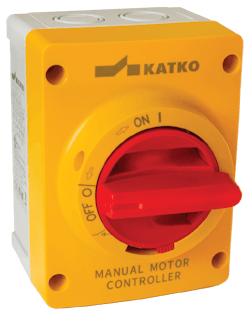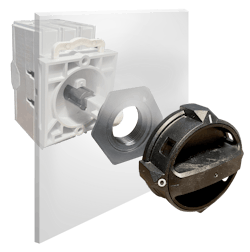Q&A: Safety First—The Role of Disconnect Switches in Industrial Applications
Disconnect switches play an important role in ensuring the safety and efficiency of industrial machinery. As key components in electrical systems, they provide a reliable means for safety isolating equipment during maintenance and emergency situations. Machine Design reached out to Klaus Tum, product director at Altech, to learn more about the importance of these devices.
Here, we dive into primary functions, variations in applications and considerations for selecting the right switch. We also look at the distinctions of making and breaking capacities and assess how these factors influence the overall reliability and efficiency of machine operations.
Machine Design: What are the primary functions of disconnect switches and machine design, and how do they enhance safety and maintenance procedures?
Klaus Tum: The primary function of a disconnect switch is to safely turn the power on and off. A disconnect switch usually is part of the power circuit of a panel that controls various aspects of machine operations. The use of a shaft and external door interlock handle along with the disconnect will ensure that the panel door can only be opened when the power is turned off.
Disconnect switches can also be used in secondary and/or control circuits to control power to an individual circuit or a bank of individual circuits. The disconnects are then used with different handles or door mount kits as they sit on the inside of the panel and where the door interlock function is not necessary or required.
MD: How do the various types of disconnect switches—such as fused, non-fused and enclosed switches—differ in their applications within industrial machinery?
KT: Fused disconnect switches are used in place of large, molded case circuit breakers (MCCBs). Non-fused disconnect switches are used when the application requires a “power” switch and circuit protection is provided by other means such as a large MCCB, miniature circuit breakers (MCBs), fuse, etc., downstream.
Enclosed disconnect switches are predominately used close to the load. For example, the National Electric Code (NEC) requires a “local” disconnect in line of sight of a motor. They are also used on the outside of panels where the control of a certain circuit is essential, but access to adjacent circuits inside the panel is not necessary.
MD: What are the key considerations when selecting a disconnect switch for a specific machine design to ensure compliance with safety standards?
KT: Key considerations include electrical ratings, type of load, location and environment, safety standards compliance, mechanical durability, mounting options, isolation capability, operation mode, indicators and accessibility, cost, availability and compatibility.
The switch should be rated for the maximum voltage and current it will encounter in the application. It should also be able to withstand potential short circuit currents without failing. Regarding the type of load, consider whether it is resistive, inductive or capacitive, as this will affect the type of switch and its features, such as arc suppression.
Operate the switch within the temperature range specified by the manufacturer. For outdoor or harsh environments, look for switches with appropriate ingress protection (IP) ratings for durability against moisture, dust and other elements.
Confirm that the switch complies with relevant safety standards, including panel rating (UL 508A, UL power distribution or lighting panel, NFPA79, etc.), kAIC rating, UL Type rating (environmental rating such as UL Type 4, 4X, 12, etc.), OSHA and NEC requirements.
Ensure the switch will meet the operational demands of the application, including the number of operations expected over its lifetime. Mounting options are another thing to consider. The switch should be mountable in the intended orientation and in the space available in the machine design. Additionally, there should be sufficient isolation from the power supply to ensure that maintenance can be performed safely.
Finally, evaluate the cost-effectiveness of the switch in relation to the budget of the machine design without sacrificing quality and compliance standards.
MD: Can you explain the significance of the “making” and “breaking” capacities of a disconnect switch in relation to its performance in electrical circuits?
KT: In short, making is closing the circuit; breaking is opening the circuit. Altech/Katko disconnect switches do not differentiate between the two operations. The internal switching mechanism is mirrored in both directions (of operation). They are UL tested during short circuit tests (so-called “O” and “CO” shots) and overload/endurance tests (6,000 operations under current load/4,000 operations with no load) to simulate these making and breaking conditions.
MD: How do disconnect switches contribute to the overall reliability and efficiency of machine operations, particularly in critical environments?
KT: If properly selected, the disconnect switch is built so robustly that it can be considered almost your last line of “defense,” meaning it should be one of the last things that ever breaks in an application, therefore contributing to the safety and reliability of the installation.
About the Author
Sharon Spielman
Technical Editor, Machine Design
As Machine Design’s technical editor, Sharon Spielman produces content for the brand’s focus audience—design and multidisciplinary engineers. Her beat includes 3D printing/CAD; mechanical and motion systems, with an emphasis on pneumatics and linear motion; automation; robotics; and CNC machining.
Spielman has more than three decades of experience as a writer and editor for a range of B2B brands, including those that cover machine design; electrical design and manufacturing; interconnection technology; food and beverage manufacturing; process heating and cooling; finishing; and package converting.
Email: [email protected]
LinkedIn: @sharonspielman
Facebook: Machine Design
YouTube: @MachineDesign-EBM



